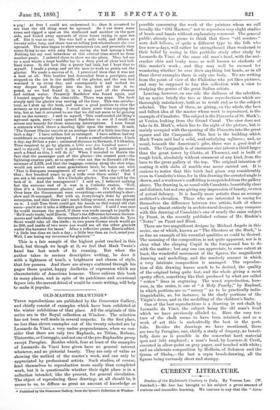OLD-MASTER DRAWINGS.*
THESE reproductions are published by the Grosvenor Gallery, and chiefly consist of examples which have been exhibited at the winter exhibitions of that place. All the originals of this series are in the Royal collection at Windsor. The selection has not been well made in several respects. In the first place, no less than eleven examples out of the twenty selected are by Leonardo da Vinci, a very undue preponderance, when we con- sider that there are only two Raphaels, no Titian, Rubens, Tintoretto, or Correggio, and not one of the pre-Raphaelite group except Perugino. Besides which, four at least of the examples of Leonardo da Vinci here given have no general interest whatever, and no pictorial beauty. They are only of value as showing the method of the master's work, and can only be appreciated by professional artists. Such studies, of course, lend themselves to reproduction more easily than completed -work, but it is questionable whether their right place is in a collection intended, like the present, for general circulation. The object of reproducing these drawings at all should be, it seems to us, to diffuse as great an amount of knowledge as 1k Published by the Grosvenor Gallery, from the Queen's Collection at Windsor.
possible • concerning the work of the painters whom we call broadly the " Old Masters," not to reproduce very slight studies of heads and hands without explanatory comment. The general public, already too prone to think that these "old masters" were dull fellows, of quite a different type to the folk who live now-a-days, will rather be strengthened than weakened in their belief by seeing in this portfolio study after study by Leonardo da Vinci of the same old man's head, with the nut- cracker chin and beaky nose, so well known to students of this master's work ; and they may well be excused for wondering whether he ever drew anything but heads, as in all these clever examples there is only one body. We are writing from the point of view of the Philistine who yet likes pictures, and may be supposed to buy this collection with a view to studying the genius of the great Italian artists.
Leaving, however, on one side the dullness of the selection, let us notice briefly the two or three reproductions which are thoroughly satisfactory, both as to result and as to the subject selected. The best of these, as giving, on the whole, the best and fullest idea of the master whose work is reproduced, is the example of Canaletto. The subject is the Piazzetta of St. Mark's, at Venice, looking from the Grand Canal. The view does not take in St. Mark's, which lies to the right of the picture, but is mainly occupied with the opening of the Piazzetta into the great square and the Campanile. This last is the building which Mark Twain said had a solid, soul-satisfying ugliness ; and, as usual, beneath the American's gibe, there was a good deal of truth. The Campanile is of enormous size (about a third larger than the great tower by Giotto, at Florence), and is built of rough brick, absolutely without ornament of any kind, from the base to the great gallery at the top. The original intention of coating it with slabs of marble was never carried out. It is curious to notice that this brick had given way considerably even in Canaletto's time, for in this drawing the serrated angle is shown, and a workmen's scaffolding is suspended from the gallefy above. The drawing is, as usual with Canaletto, beautifully clear and distinct, but not one giving any impression of beauty, or even of actual delicacy. It is hardly more artistic than an average architect's elevation. Those who are interested in seeing for themselves the difference between two artists, both of whose work lay almost entirely in architectural designs, may compare with this drawing of Canaletto's one of nearly the same subject by Prout, in the recently published volume of Mr. Ruskin's "Notes" on Prout and Hunt.
There are two magnificent designs by Michael Angelo in this series, one of which, known as " The Shooters at the Mark," is as fine an example of his essential qualities as could be desired. The meaning of the composition is not quite apparent, nor is it clear what the sleeping Cupid in the foreground has to do with the matter; but any one can appreciate, to some extent at least, the wonderful movement of the figures, the magnificent drawing and modelling, and the masterly manner in which a very intricate composition is managed. The reproduc- tion of this drawing leaves much to be desired, the quality of the original being quite lost, and the whole giving a most spotty effect, something like that produced by what are called " rotten " lines in engraving. The worst reproduction, how- ever, in the series, is one of "A Holy Family," by Raphael, in which portions are so " muzzy " as to be practically indis- tinguishable, as, for instance, in the shady portions of the Virgin's dress, and in the modelling of the children's limbs.
One of the best reproductions is a drawing in red chalk by Leonardo da Vinci, the subject being the old man's head which we have previously alluded to. Here the very tex- ture of the chalk seems to have been retained, and as a work of art this is undoubtedly the best in the port- folio. Besides the drawings we have mentioned, there are two by Perugino, one, chiefly a study of drapery, as beauti- fully done as is possible in the somewhat hard material (pen and ink) employed ; a man's head, by Lorenzo di Credi, executed in silver-point on grey paper, and touched with white ; and an elaborate composition by Holbein, of Solomon and the Queen of Sheba,—the last a sepia brush-drawing, all the figures being curiously short and stumpy.


































 Previous page
Previous page